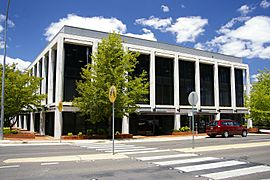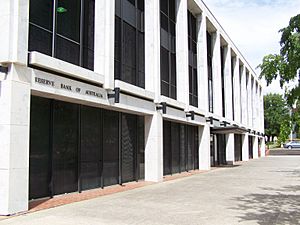Reserve Bank of Australia Building, Canberra facts for kids
Quick facts for kids Reserve Bank of Australia Building |
|
|---|---|

Reserve Bank of Australia building, 2009
|
|
| General information | |
| Architectural style | Modernist |
| Address | 20-22 London Circuit, City, Canberra, Australian Capital Territory |
| Country | Australia |
| Coordinates | 35°16′49″S 149°07′37″E / 35.2804°S 149.1270°E |
| Construction started | 1965 |
| Completed | 1967 |
| Renovated | 1983, 1988, 1994 |
| Cost | £307,353 |
| Owner | Reserve Bank of Australia |
| Technical details | |
| Material | Marble, timber, glass, concrete |
| Design and construction | |
| Architecture firm | Howlett and Bailey |
| Other designers |
|
| Main contractor | Civil & Civic |
| Official name: Reserve Bank of Australia | |
| Type: | Listed place (Historic) |
| Criteria: | A., D., E., and F. |
| Designated: | 22 June 2004 |
| Reference #: | 105396 |
The Reserve Bank of Australia Building is a special bank building in Canberra, Australia. It is located at 20-22 London Circuit in the city area. This building was designed by Howlett and Bailey in 1962. It was built between 1963 and 1965 by a company called Civil & Civic. This building is important because it is on the Commonwealth Heritage List, which means it is protected for its historical value.
A Look Back: The Bank's History
Early Banking in Canberra
Banking in Canberra started very early, on January 13, 1913. The Savings Bank Department of the Commonwealth Bank opened its doors. A week later, both savings and general banking began. These first bank services were in a room at the Administrative Offices in Acton.
In October 1913, the Commonwealth Bank moved into its own building. This building was also in Acton. Later, in June 1925, people started talking about a permanent home for the Commonwealth Bank in Canberra. The bank agreed and looked for good places.
Finding a New Home
In April 1926, the Commonwealth Bank bought land for its new building. This land was on Northbourne Avenue and City Circuit (now London Circuit). The bank had to build something that matched the city's design plans. The new building was finished in October 1927. It became part of the Melbourne Building.
The Reserve Bank Gets Its Own Building
The Reserve Bank of Australia used to be part of the Commonwealth Bank. When it became its own separate bank, it still shared space. The Reserve Bank quickly started looking for its own building. It worked with the National Capital Development Commission (NCDC). The NCDC was in charge of planning Canberra.
The NCDC first offered one site, but then changed its mind. They then offered a new site on London Circuit. This spot was perfect, near a planned shopping area and a legal area. The Reserve Bank agreed to this spot in May 1961.
Designing the New Bank
The Reserve Bank building was designed through a special competition. Architects from all over Australia could submit their ideas. The NCDC managed this competition. They wanted a building that looked good from all sides. It needed a copper roof and air conditioning.
The bank also had specific needs inside. It needed a large banking area for customers. There had to be a secure area for handling cash. This cash area needed very thick walls for safety. The total cost for the building was not supposed to be more than 250,000 old Australian pounds.
Building the Reserve Bank
Many architects entered the competition. The winners were Howlett and Bailey from Perth. The building cost more than expected, about 307,353 old Australian pounds. Construction started in 1963 and finished in 1965.
Inside the banking area, there was special artwork. Margo Lewers created a copper sculpture called "Four Pieces." Another sculpture by Donald Brook was in the roof garden. This one was later moved to the Canberra Museum and Gallery.
Changes Over Time
Over the years, the building has been updated many times. In 1978, the phone, lighting, and electrical systems were improved. The outside mosaic tiles were replaced with marble in 1981.
Major renovations happened in 1983 and 1988. These changes helped the building adapt to new technology. For example, the cash handling area was redesigned. More space was created by filling in an open area called an atrium. Later, in 1994, parts of the building were changed to rent out to other businesses. These changes show how banking has moved towards a cashless society.
Why the Design Matters
The original design of the Reserve Bank building showed how banking used to work. It was all about handling cash safely. The strong room was in the middle of the building. The large banking area made people feel secure. It also showed how important the Reserve Bank is to Australia's money system.
The Reserve Bank building was the second important building in its area. It was built near the Law Courts. The Federal Police Headquarters was the third building. Together, these buildings show how Canberra was carefully planned.
What the Building Looks Like
The Reserve Bank of Australia building is a beautiful and well-proportioned structure. It is made of strong and attractive materials like marble, timber, glass, and concrete. It is an example of modernist design. This style often uses simple shapes and clean lines.
Key Architectural Features
The building looks light and airy. It has a regular pattern of columns and beams. The design uses a contrast between the marble-covered columns and the glass walls. The details are very precise. The columns are shaped like a cross. They make the low building seem taller.
The ground floor has a strong, solid wall. This shows where the secure cash handling area is inside. This design choice is typical of modernist buildings.
Inside the Banking Chamber
The most important room inside is the banking chamber. It has a central entrance with a black slate floor. The rest of the floor is carpeted. A large copper sculpture by Gerald and Margo Lewers is a main feature. It is called "Four Pieces."
The banking counter is also very striking. It is made of laminated timber with a marble top. The room feels bright because of the tall glass windows on three sides. The ceiling has a special pattern called "coffered." This banking chamber is very important for its history and design.
The Secure Strong Room
The strong room is entered through a glass sliding door from the banking chamber. It has a special door by John Tam (Australia). Inside, metal grills divide the space. The floor has a parquet pattern. The strong room's design shows how important cash handling was when the bank was built. It was the heart of the building.
The Building's Surroundings
The Reserve Bank building faces a courtyard. This courtyard was designed to be a setting for the Law Courts. The Federal Police Headquarters was also built nearby. The design of these buildings fits together well. They use similar materials like marble and have flat roofs. This creates a harmonious look for the whole area.
Current Condition
Some changes have been made to the building over time. Sunscreens were added to the glass areas. This makes the banking chamber less transparent than it was originally. Also, the original mosaic tiles on the outside were replaced with marble.
Why the Building is Special
The Reserve Bank of Australia building is on the Commonwealth Heritage List. It was added on June 22, 2004. This means it is recognized for several important reasons.
Its Role in Australia's History
The Reserve Bank building is important because it represents Australia's central bank. It shows how the Reserve Bank separated from the Commonwealth Bank. This separation was key for managing Australia's money system.
Its Architectural Style
This building is one of three important buildings in its area. They all show a style called "Stripped Classical." This style uses simple rectangular shapes, columns, and a balanced look. The sculptures inside the Reserve Bank also show the art styles of that time. They highlight how art was used to decorate public places.
Its Beautiful Design
The Reserve Bank building is beautiful because of its simple, elegant design. It fits well with the other buildings around it. The light grey marble makes it look bright and inviting. Its position also makes the nearby Law Courts building look even more important and dignified. The bank building helps frame the view towards Black Mountain.
A Technical Achievement
The Reserve Bank of Australia building, built from 1963 to 1965, is a key part of the Law Courts area. This area is a great example of Canberra's city planning. It shows how buildings can be placed to create important views and spaces. The bank's design also gives a strong feeling of security. The banking chamber inside is very impressive, with its tall ceilings and special artwork.


